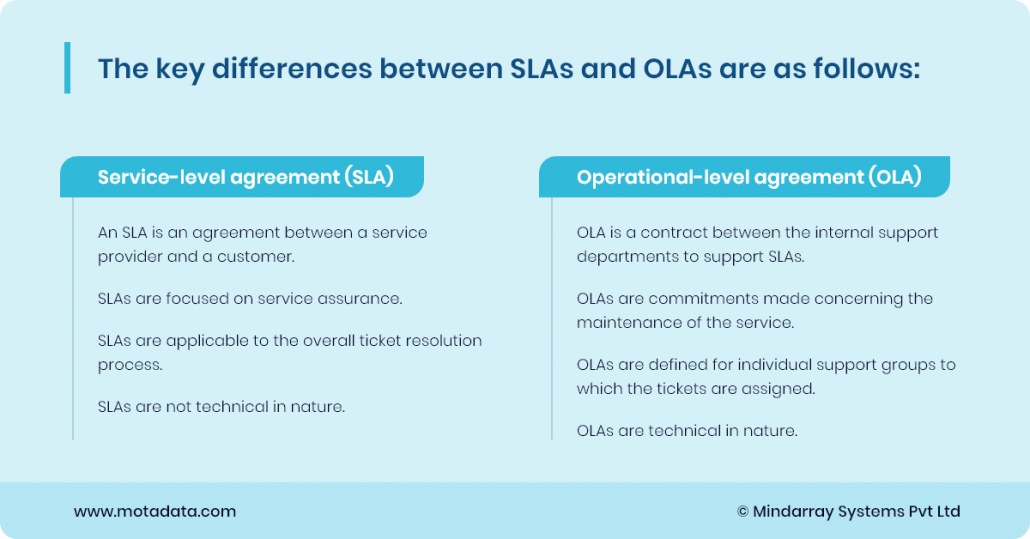In traditional IT environments, organizations deliver and support services to customers.
The organization creates a Service Level Agreement (SLA) that outlines service availability, reliability, and potential penalties for downtime.
The internal teams like the network administration team, development team, IT service desk, etc.
would then draw up Operational Level Agreements (OLAs) to support the SLA.
This used to be an easy process to manage.
As IT environments grow more complex, several internal and external teams must collaborate to meet customer expectations.
So now there is not only an SLA that you negotiated with your customer, and its supporting internal OLAs, but also SLAs that you as a customer have agreed upon with your own suppliers.
These SLAs are technically also OLAs that support the SLA drawn up with your own customer.
Confused?
We don’t blame you! It is enough to turn the process of negotiating SLAs with your customers very complicated.
Therefore, understanding the difference between the two types of agreements is of extreme importance.
But first, let us look at what each type of agreement means, and then dive deep into what makes them different.
What are SLAs?
A Service Level Agreement (SLA) is an agreement or a contract between a service provider and its customer about providing services that meet the customer’s expectations.
SLAs are all about addressing business level requirements and managing business expectations e.g., how long can the business expect a service to be down if there is an outage.
SLAs define the scope of services requested by the customer, the metrics used to measure service performance, and penalties if the agreed service level is not achieved.
Technology companies’ SLAs may include network uptime commitment of 99.99%.
If the service provider fails to meet expectations, the customer can reduce their payment by a certain percentage based on the extent of the outage.
If you want to know more about how to set, measure and report SLAs, check our blog on 5 Practical tips to set, measure and report SLAs.
Importance of SLA
An SLA is for the end-user‘s peace of mind. They will have an SLA so that they can refer to it whenever they require to hold their vendor accountable.
It also lists down the details about which type of service they will get.
When services fall short, customers can also seek monetary compensation to mitigate some of the impacts.
For many organizations, this is the form of assurance they need to begin a strong relationship with a new partner with whom they have not worked before.
What are OLAs?
An Operational Level Agreement (OLA) is a commitment or an agreement that a service provider establishes for its internal customers to comply with SLAs.
To provide seamless service delivery, both SLA and OLA need to be used cohesively.
The assurance made in the SLA must be tangible and entirely backed by the OLA.
The OLAs are used to monitor internal service agreements like response time for incidents, problems assigned to IT groups, availability of servers that support multiple applications, etc.
OLAs clearly define what group within the IT department will provide what kind of support within the defined boundaries of the SLA.
OLAs outline things like how the service desk should respond to incidents and requests, what protocols the service teams must undertake to get critical services up and running, what the DBAs should do to optimize the databases, what the desktop team should do to patch the desktop systems, etc.
What is the difference between SLAs and OLAs?
When defining such agreements, the most common mistake that the service providers make is negotiating an SLA with the customer before discussing and negotiating OLAs with internal support teams only to realize that the established SLA cannot be sustained and the whole process must be started afresh.
So, understanding the difference between the two helps in identifying any cost differentials, constraints, and other dynamics before negotiating on an SLA.
The key differences between SLAs and OLAs are as follows:
1. SLAs are essentially agreements between a service provider and a customer. OLAs are contracts between the internal support departments of an organization that provisioned the SLAs.
2.SLAs focus on the service aspect of the agreement, such as service uptime and performance. In contrast, OLAs outline commitments related to service maintenance.
3. SLAs apply to the overall ticket resolution process, while OLAs define expectations for individual support groups handling assigned tickets.
4. The Operational Level Agreements are more technical in nature than the Service Level Agreements.
5. The SLAs associate service providers with customers unlike the OLAs, so the SLAs have a larger target group than the OLAs.
Lets try to understand these two terms in a different context.
If you build a house, you establish a Service Level Agreement with the general contractor, specifying what needs to be done and when.
The contract that the general contractor draws up with all his workers and laborers would be an Operational Level Agreement.
Summary
The Service Level Agreements and Operational Level Agreements are important for service providers to manage service delivery and ensure customer satisfaction.
So, organizations need to make sure that all the agreements in place are consistent and well supported by their internal teams.
SLAs and OLAs can contain similar types of information but understanding the difference between them will ensure seamless service delivery.
FAQs:
An SLA is a formal agreement between a service provider and a client that outlines the expected level of service, including performance metrics and responsibilities.
An OLA is an internal agreement within an organization that defines the responsibilities and service level targets of different teams or departments to support the SLA.
SLAs are external agreements with customers, while OLAs are internal agreements within an organization. SLAs focus on service delivery to clients, whereas OLAs ensure that internal teams collaborate effectively to meet SLA commitments.
Organizations should involve stakeholders in the creation process, set realistic metrics, ensure clarity in language, and regularly review and update the agreements.




